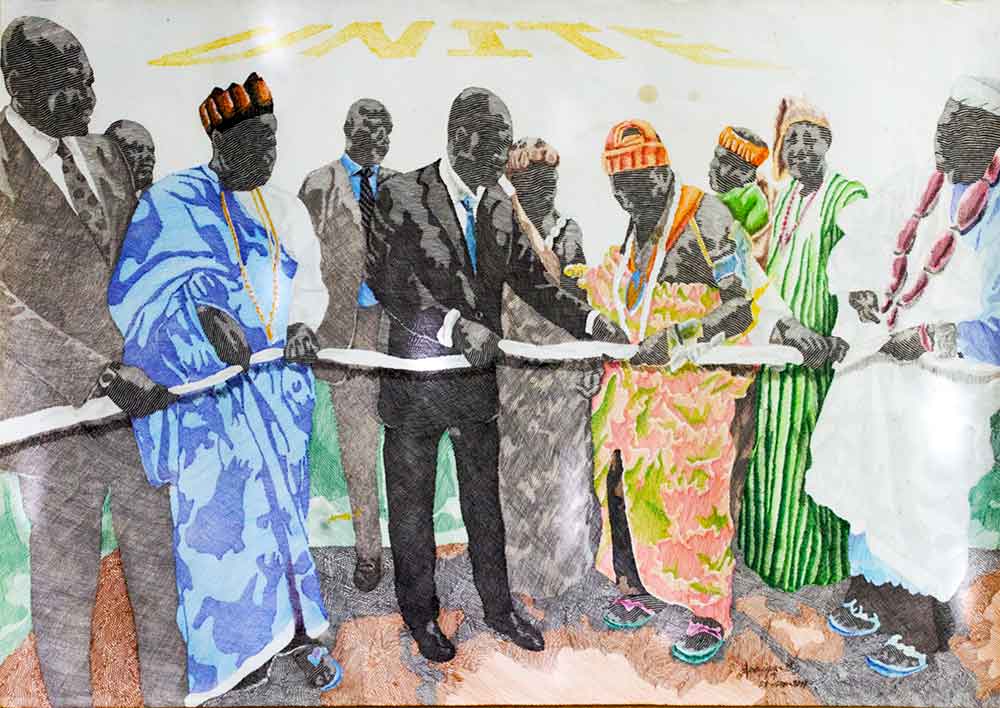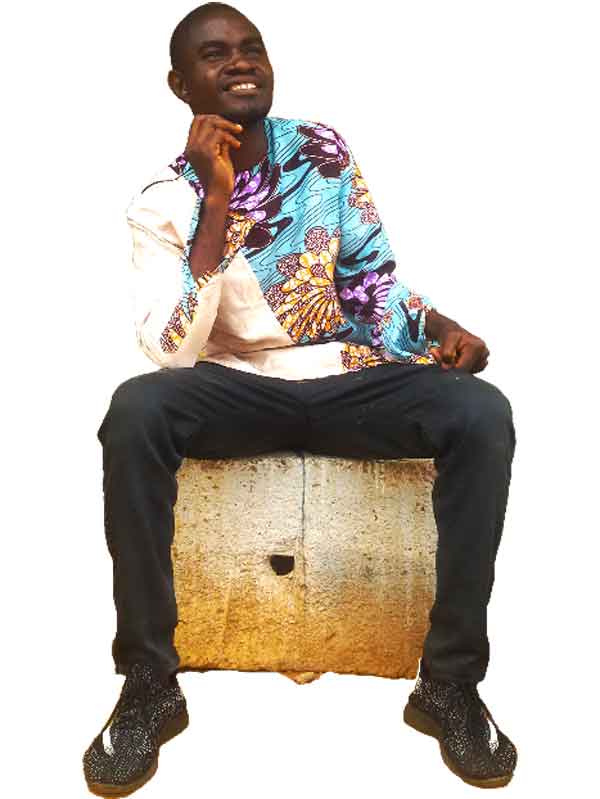
Dieudonné ASSIGA: L’unité, 2017, stylo sur papier, 87,6 × 61,6 cm
FR: En 2017, un conflit tend à diviser le Cameroun entre la zone francophone et la zone anglophone. Cela nait du fait que la partie Anglophone qui englobe les Régions du Nord-Ouest et du Sud-Ouest (NOSO) soit lésée et marginalisée dans les stratégies de développement. Cette année-là, certains corps de métiers de ces zones engagent des grèves pour faire entendre leurs revendications. Ces revendications vont favoriser des violences et la naissance des sécessionnistes nommés « Ambazoniens » qui voudraient l’autodétermination de cette partie du Cameroun. Suite à cette situation, le Président de la République du Cameroun va convoquer un Dialogue National en 2019 qui a pour objectif de trouver des solutions à cette crise. L’une des recommandations étant la réconciliation nationale. C’est cette réconciliation que l’artiste a représentée sur cette œuvre.
Il y représente les dix régions du Cameroun par un groupe d’individus qui tiennent un ruban blanc, symbole de lien, du vivre ensemble et de paix. Ces individus portent différents vêtements traditionnels et modernes pour symboliser la diversité culturelle de ce pays.
EN: In 2017, a conflict is tending to divide Cameroon between the Francophone and Anglophone zones. This arose from the fact that the Anglophone part of the country, which includes the North West and South West Regions (NOSO), was neglected and marginalised in development strategies. That year, certain trades in these areas went on strike to make their demands heard. These demands led to violence and the emergence of secessionists called 'Ambazonians' who wanted self-determination for this part of Cameroon. As a result of this situation, the President of the Republic of Cameroon convened a National Dialogue in 2019 with the aim of finding solutions to this crisis. One of the recommendations is national reconciliation. It is this reconciliation that the artist has represented in this work.
It represents the ten regions of Cameroon by a group of individuals holding a white ribbon, a symbol of connection, living together and peace. These individuals wear different traditional and modern clothes to symbolise the cultural diversity of the country.

FR: Né le 18 juillet 1986 à Bélabo dans la région de l’est du Cameroun, Dieudonné ASSIGA NDONO vit et travaille à Mfou, non loin de Yaoundé. En 2007, il suit une formation cinématographique au Centre de Formation professionnelle de l’Audiovisuel de la CRTV (CFPA/CRTV) de Yaoundé où il découvre la technique des ombres chinoises qui aura une influence majeure dans son œuvre. En plus de l’ombre chinoise, son travail se caractérise par des portraits ou des scènes dans lesquelles il excelle dans l’utilisation de trois types lignes à savoir : la ligne sujette qu’il utilise pour ses personnages, la ligne complémentaire qui lui permet d’interpréter son environnement et la ligne accessoire, inspirée de l’empreinte digitale qu’il utilise pour mettre en évidence certains éléments particuliers. Entre 2015 et 2017, il participe plusieurs fois au Salon international de l’artisanat du Cameroun (SIAC) où il est distingué à de nombreuses éditions. À l’occasion de la visite officielle du président de la République italienne Sergio MATTARELLA au Cameroun en mars 2016, il fait partie des artistes sélectionnés pour l’exposition en son honneur à l’IFA de Mbalmayo.
EN: Born in Bélabo in the eastern region of Cameroon in 1986, Dieudonné ASSIGA NDONO lives and works in Mfou, not far from Yaoundé. In 2007, he attended a film training course at the CRTV's Centre de Formation Professionnelle de l'Audiovisuel (CFPA/CRTV) in Yaoundé, where he discovered the technique of shadow puppetry, which has had a major influence on his work. In addition to shadow puppetry, his work is characterised by portraits or scenes in which he excels in the use of three types of lines: the subject line which he uses for his characters, the complementary line which allows him to interpret his environment and the accessory line, inspired by the fingerprint which he uses to highlight certain particular elements. Between 2015 and 2017, he participated several times in the Salon International de l'Artisanat du Cameroun (SIAC) where he was awarded in many editions. On the occasion of the official visit of the President of the Italian Republic Sergio MATTARELLA to Cameroon in March 2016, he was one of the artists selected for the exhibition in his honour at the IFA in Mbalmayo.
